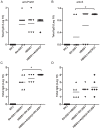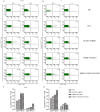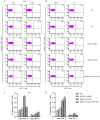Optimisation of prime-boost immunization in mice using novel protein-based and recombinant vaccinia (Tiantan)-based HBV vaccine
- PMID: 22970140
- PMCID: PMC3435326
- DOI: 10.1371/journal.pone.0043730
Optimisation of prime-boost immunization in mice using novel protein-based and recombinant vaccinia (Tiantan)-based HBV vaccine
Abstract
Background: A therapeutic vaccine for chronic hepatitis B virus (HBV) infection that enhances virus-specific cellular immune responses is urgently needed. The "prime-boost" regimen is a widely used vaccine strategy against many persistence infections. However, few reports have addressed this strategy applying for HBV therapeutic vaccine development.
Methodology/principal findings: To develop an effective HBV therapeutic vaccine, we constructed a recombinant vaccinia virus (Tiantan) containing the S+PreS1 fusion antigen (RVJSS1) combined with the HBV particle-like subunit vaccine HBVSS1 to explore the most effective prime-boost regimen against HBV. The immune responses to different prime-boost regimens were assessed in C57BL/C mice by ELISA, ELISpot assay and Intracellular cytokine staining analysis. Among the combinations tested, an HBV protein particle vaccine priming and recombinant vaccinia virus boosting strategy accelerated specific seroconversion and produced high antibody (anti-PreS1, anti-S antibody) titres as well as the strongest multi-antigen (PreS1, and S)-specific cellular immune response. HBSS1 protein prime/RVJSS1 boost immunization was also generated more significant level of both CD4+ and CD8+ T cell responses for Th1 cytokines (TNF-α and IFN-γ).
Conclusions: The HBSS1 protein-vaccine prime plus RVJSS1 vector boost elicits specific antibody as well as CD4 and CD8 cells secreting Th1-like cytokines, and these immune responses may be important parameters for the future HBV therapeutic vaccines.
Conflict of interest statement
Figures






Similar articles
-
Recombinant vaccinia vector-based vaccine (Tiantan) boosting a novel HBV subunit vaccine induced more robust and lasting immunity in rhesus macaques.Vaccine. 2017 Jun 5;35(25):3347-3353. doi: 10.1016/j.vaccine.2017.04.059. Epub 2017 May 6. Vaccine. 2017. PMID: 28487055
-
Poly(I:C)/alum mixed adjuvant priming enhances HBV subunit vaccine-induced immunity in mice when combined with recombinant adenoviral-based HBV vaccine boosting.PLoS One. 2013;8(1):e54126. doi: 10.1371/journal.pone.0054126. Epub 2013 Jan 15. PLoS One. 2013. PMID: 23335993 Free PMC article.
-
HBV antigen and DNA loss from mouse serum is associated with novel vaccine-induced HBV surface antigen-specific cell-mediated immunity and cytokine production.Antiviral Res. 2019 Jan;161:20-27. doi: 10.1016/j.antiviral.2018.11.002. Epub 2018 Nov 10. Antiviral Res. 2019. PMID: 30423362
-
Protective efficacy and hepatitis B virus clearance in mice enhanced by cell-mediated immunity with novel prime-boost regimens.J Viral Hepat. 2017 Apr;24(4):337-345. doi: 10.1111/jvh.12649. Epub 2016 Nov 25. J Viral Hepat. 2017. PMID: 27885748
-
The immune response of rhesus macaques to novel vaccines comprising hepatitis B virus S, PreS1, and Core antigens.Vaccine. 2018 Jun 18;36(26):3740-3746. doi: 10.1016/j.vaccine.2018.05.061. Epub 2018 May 16. Vaccine. 2018. PMID: 29778513
Cited by
-
Protective Efficacy of the Conserved NP, PB1, and M1 Proteins as Immunogens in DNA- and Vaccinia Virus-Based Universal Influenza A Virus Vaccines in Mice.Clin Vaccine Immunol. 2015 Jun;22(6):618-30. doi: 10.1128/CVI.00091-15. Epub 2015 Apr 1. Clin Vaccine Immunol. 2015. PMID: 25834017 Free PMC article.
-
From lesions to viral clones: biological and molecular diversity amongst autochthonous Brazilian vaccinia virus.Viruses. 2015 Mar 16;7(3):1218-37. doi: 10.3390/v7031218. Viruses. 2015. PMID: 25785515 Free PMC article.
-
Sweeten PAMPs: Role of Sugar Complexed PAMPs in Innate Immunity and Vaccine Biology.Front Immunol. 2013 Sep 2;4:248. doi: 10.3389/fimmu.2013.00248. Front Immunol. 2013. PMID: 24032031 Free PMC article. Review.
-
Immunogenicity of a vaccinia virus-based severe acute respiratory syndrome coronavirus 2 vaccine candidate.Front Immunol. 2022 Jul 22;13:911164. doi: 10.3389/fimmu.2022.911164. eCollection 2022. Front Immunol. 2022. PMID: 35935962 Free PMC article.
-
Comprehensive Analysis of the Safety Profile of a Single-Stranded RNA Nano-Structure Adjuvant.Pharmaceutics. 2019 Sep 7;11(9):464. doi: 10.3390/pharmaceutics11090464. Pharmaceutics. 2019. PMID: 31500241 Free PMC article.
References
-
- Ganem D, Prince AM (2004) Hepatitis B virus infection–natural history and clinical consequences. N Engl J Med 350: 1118–1129. - PubMed
-
- Michel ML, Tiollais P (2010) Hepatitis B vaccines: protective efficacy and therapeutic potential. Pathol Biol 58: 288–295. - PubMed
-
- Sheppard CW, Samar EP, Finely L, Fiore AE, Bell BP (2006) Hepatitis B virus infection: epidemiology and vaccination. Epidemiology Rev 28: 112–125. - PubMed
-
- Chen HL, Chang MH, Ni YH, Hsu HY, Lee PI, et al. (1996) Seroepidemiology of hepatitis B virus infection in children: ten years of mass vaccination in Taiwan. JAMA 276: 906–908. - PubMed
-
- Zhou YH, Wu C, Zhuang H (2009) Vaccination against hepatitis B: the Chinese experience. Chin Med J (Engl) 122: 98–102. - PubMed
Publication types
MeSH terms
Substances
LinkOut - more resources
Full Text Sources
Other Literature Sources
Research Materials

